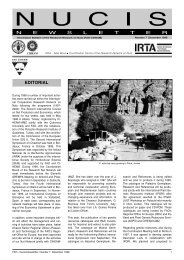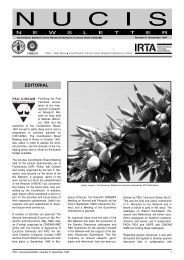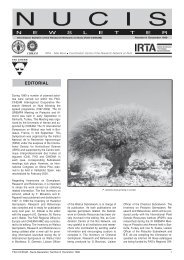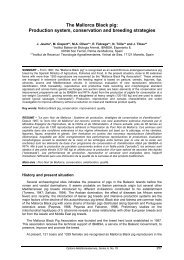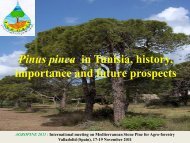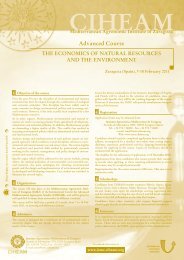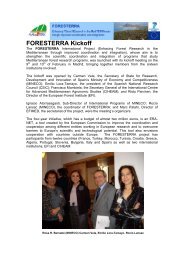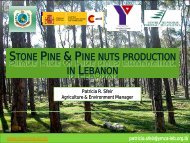NUCIS number 12. September 2004. 52 pages (full ... - IAMZ - ciheam
NUCIS number 12. September 2004. 52 pages (full ... - IAMZ - ciheam
NUCIS number 12. September 2004. 52 pages (full ... - IAMZ - ciheam
- No tags were found...
Create successful ePaper yourself
Turn your PDF publications into a flip-book with our unique Google optimized e-Paper software.
Prunus webbiiAS A WAY TO LOOK INTOSELF-COMPATIBILITYIN ALMONDINTRODUCTIONAlmond [Prunus amygdalus Batsch or P.dulcis Miller (D.A. Webb)], derives fromone or more wild almond species (suchas P. fenziliana, P. bucharica, P. kuramica,P. triloba) that evolved in the desertsof Central Asia. By 450 BC, almond startedspreading in the Mediterranean basinand countries like Italy, Spain, France,Portugal, Morocco, Tunisia became importantcentres of production (Kester andRoss, 1996).The fact that almond is mainly a self-incompatiblespecies accounts for the greatdiversity found and also for the differencesamong populations of different origins(with distinct histories of hybridization).Furthermore, as pointed out by Socias iCompany (2002) it is expected that hybridizationswith wild Mediterranean species(such as P. webbii) may have taken placeduring almond expansion, resulting in thealmond populations that can be currentlyfound in this region.SELF-INCOMPATIBILITYMany flowering plants display self-incompatibility(SI), a genetically determinedcharacteristic which prevents inbreedingby promoting outcrossing. Self-incompatibilityis determined by a single multialleliclocus, the S locus. Whenever there is amatch between the S alleles expressed inthe pistils and those of the pollen, fertilizationis hampered. In the families Solanaceae,Rosaceae and Schrophulariaceae,the products of the S locus in thepistil are S-RNases that are thought todestroy the RNA of incompatible pollen(Wang et al., 2003).Even though SI is believed to have playedan important role in the success ofAngiosperms, it represents a limitation toplant breeders when fruit production isimportant. In almond, SI is almost 100%effective, which means that unless compatiblecultivars are present in an orchard,nut production will never be achieved.It has long been the desire of almondbreeders to obtain self-compatible(SC) cultivars that are, at the same time,good almond producers.SELF-COMPATIBILITY IN ALMONDSome self-compatible almond varietieshave been identified and the self-compatibilitytrait is usually attributed to the presenceof a self-fertility allele S F(Raynaudand Grasselly, 1985). The Italian cultivar‘Tuono’ is the best characterized SC almondcultivar and analysis of stylar RNaseactivity indicate that S Fis inactive in‘Tuono’ styles and in its SC progeny(Boskovíc et al., 1999). The S Fgene sequencesegregating with SC was isolatedfrom ‘Tuono’ (Ma and Oliveira, 2000,2001; Channuntapipat et al., 2001)though so far it is not known why there isno corresponding RNase activity. Breedingtests confirmed segregation of S Fsequenceand lack of RNase activity withthe SC phenotype (Ortega and Dicenta,2003). Apparently, other SC almond cultivarsdisplay only one S-RNase in theirstyles (i.e. they lack one S-RNase) butthe corresponding genes have still notbeen isolated.THE ORIGIN OF SELF-COMPATIBILITYIN ALMOND‘Tuono’ is originally from Italy, from theregion of Apuglia (Herrero et al., 1977)where other Prunus such as P. webbii coexist.Because P. webbii is reported as aSC species, it has been assumed that SCtrait was introgressed into almond fromthis wild relative (Godini, 1979, 2000),probably through S f(Socias i Company,2002). A consequence of this assumptionis that P. webbii would have to carry theS fallele. Furthermore, if S fwas the onlycause of self-compatibility, all SC P. webbiiwould contain this (or similarly nonfunctional)allele(s). If, on the other hand,P. webbii would have functional S allelesstill being SC, then other loci should alsobe implicated in SI/SC in this species.THE S fALLELE IN P. webbiiWhen testing for the presence of S f(usingS fspecific primers) in six ecotypes of P.webbii (one from Spain and five fromApuglia) two were shown to carry the S fallele (Sanchez and Oliveira, unpublishedresults), which could account for theirself-compatibility. Since no RNase activityin the pistil can be attributed to S f, atleast half of the pollen grains would beable to grow in the pistil and set seed.Such Prunus webbii plants may have, atsome point, crossed with cultivated almondoriginating cultivars as ‘Tuono’ thatcarry S f. It must be noted that the hybridizationmust have occurred several generationsago since, as assessed by molecularmarkers, ‘Tuono’ is more closely relatedwith almond than with P. webbii(Martins et al., 2003), that is to say, ‘Tuono’is not an F 1hybrid and further crosseswith cultivated almond must have beentaken place in the origin of this cultivar.The fact that other ecotypes of P. webbiido not contain the S fallele but are still SCdismisses the notion that the presence ofS fis a sine qua non condition for selfcompatibility.OTHER S ALLELES IN P. webbiiBy using primers designed for the conservedregions of Rosaceae S alleles (Signalpeptide, C1 and C5) on P. webbii genomicDNA, it was possible to isolate otherS alleles besides S fin this species (Sanchezand Oliveira, 2003). Thus, for four ofthe six ecotypes tested, two S alleleswere isolated. As expected one of thesealleles was S fin the two ecotypes alreadyshown to carry S f. For the two remainingecotypes, only one S allele was found.The fact that P. webbii genome containsS-alleles does not constitute in itself asurprise. If SI was the original condition inPrunus and SC plants are derived from SIplants, it could be expected that all plantsof this genus may carry S-RNase genesthough some may be in a relic non-functionalform. Nevertheless, testing S-geneexpression on pistil RNA from four varietiesby RT-PCR, amplification was successful.This means that at least some P.webbii S-alleles are pistil-expressed suggestingthat these genes may be functional,a feature that could be confirmed bytesting the RNase activity of P. webbiipistils.S-ALLELESAND SELF-COMPATIBILITYHow plants carrying the S fallele could beself-compatible was already explained.Similarly plants carrying a single S allelemay be accounted for if we consider thatnot being able to isolate a second S-alleleis due to either its absence from the genomeor (more likely) an allele mutated tosuch an extreme that it is no longer recognisableby the primers and therefore itis most likely non-functional. The possibilitythat these individuals are homozygousfor the S-locus (since P. webbii is SC thiswould be possible) and therefore to identicalS-alleles are present which wouldnot be distinguishable by PCR. As for theecotypes that carry two distinct S-allelesthat as judged by their sequence seem tocode putatively functional S-RNases, thecause of SC may be due to a lack of (orreduced) expression of the S-genes (oneor both) or SC may be a result of the actionof other genes outside of the S-locus.It has long been known that the geneticbackground also affects the self-incompatibilityresponse.Self-fertile varieties of SI species areknown in other plants and in many casesmutations in the S-RNase coding regionor low expression levels of this proteincan explain self-fertility (Kowyama et al.,1994; Royo et al., 1994; Sassa et al.,1997). However other factors such asmutations on the putative S-pollen counterpartor at modifier loci can account forSC in the presence of <strong>full</strong>y functional S-RNases (Ai et al., 1991; Golz et al., 1998;Tao et al., 2002 and Tsukamoto et al.,2003). Similar situations are not to be discardedin Prunus webbii.8 FAO-CIHEAM - Nucis-Newsletter, Number 12 <strong>September</strong> 2004



